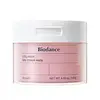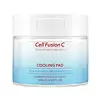What's inside
What's inside
 Key Ingredients
Key Ingredients

 Benefits
Benefits

 Ingredients Side-by-side
Ingredients Side-by-side

Water
Skin ConditioningCollagen Water
HumectantButylene Glycol
Humectant1,2-Hexanediol
Skin ConditioningPolyglyceryl-10 Laurate
Skin ConditioningGlycerin
HumectantEthylhexylglycerin
Skin ConditioningArginine
MaskingAllantoin
Skin ConditioningCarbomer
Emulsion StabilisingXanthan Gum
EmulsifyingDisodium EDTA
Sodium Polyacrylate
AbsorbentCyanocobalamin
Skin ConditioningPalmitoyl Tripeptide-5
Skin ConditioningHydrolyzed Hyaluronic Acid
HumectantCollagen Extract
Skin ConditioningHydrolyzed Elastin
EmollientGalactomyces Ferment Filtrate
HumectantHyaluronic Acid
HumectantSh-Polypeptide-22
Skin ConditioningSh-Oligopeptide-1
Skin ConditioningSh-Polypeptide-1
Skin ConditioningSh-Oligopeptide-2
Skin ConditioningSh-Polypeptide-3
Skin ConditioningWater, Collagen Water, Butylene Glycol, 1,2-Hexanediol, Polyglyceryl-10 Laurate, Glycerin, Ethylhexylglycerin, Arginine, Allantoin, Carbomer, Xanthan Gum, Disodium EDTA, Sodium Polyacrylate, Cyanocobalamin, Palmitoyl Tripeptide-5, Hydrolyzed Hyaluronic Acid, Collagen Extract, Hydrolyzed Elastin, Galactomyces Ferment Filtrate, Hyaluronic Acid, Sh-Polypeptide-22, Sh-Oligopeptide-1, Sh-Polypeptide-1, Sh-Oligopeptide-2, Sh-Polypeptide-3
Water
Skin ConditioningMethylpropanediol
SolventGlycerin
HumectantDipropylene Glycol
HumectantChamomilla Recutita Extract
Skin ConditioningChrysanthemum Parthenium Extract
Skin ConditioningPinus Pinaster Bark Extract
AntioxidantSodium Hyaluronate
HumectantPanthenol
Skin ConditioningBetaine
HumectantTrehalose
HumectantPolyglyceryl-10 Laurate
Skin ConditioningXanthan Gum
EmulsifyingMethyl Diisopropyl Propionamide
MaskingCarbomer
Emulsion StabilisingDisodium EDTA
Tromethamine
BufferingAllantoin
Skin ConditioningButylene Glycol
HumectantAcrylates/C10-30 Alkyl Acrylate Crosspolymer
Emulsion StabilisingAmmonium Acryloyldimethyltaurate/Vp Copolymer
Guaiazulene
AntimicrobialGlyceryl Polymethacrylate
Acetyl Hexapeptide-8
HumectantAspartic Acid
Masking1,2-Hexanediol
Skin ConditioningHydroxyacetophenone
AntioxidantWater, Methylpropanediol, Glycerin, Dipropylene Glycol, Chamomilla Recutita Extract, Chrysanthemum Parthenium Extract, Pinus Pinaster Bark Extract, Sodium Hyaluronate, Panthenol, Betaine, Trehalose, Polyglyceryl-10 Laurate, Xanthan Gum, Methyl Diisopropyl Propionamide, Carbomer, Disodium EDTA, Tromethamine, Allantoin, Butylene Glycol, Acrylates/C10-30 Alkyl Acrylate Crosspolymer, Ammonium Acryloyldimethyltaurate/Vp Copolymer, Guaiazulene, Glyceryl Polymethacrylate, Acetyl Hexapeptide-8, Aspartic Acid, 1,2-Hexanediol, Hydroxyacetophenone
 Reviews
Reviews

Ingredients Explained
These ingredients are found in both products.
Ingredients higher up in an ingredient list are typically present in a larger amount.
1,2-Hexanediol is a synthetic liquid and another multi-functional powerhouse.
It is a:
- Humectant, drawing moisture into the skin
- Emollient, helping to soften skin
- Solvent, dispersing and stabilizing formulas
- Preservative booster, enhancing the antimicrobial activity of other preservatives
Allantoin is a soothing ingredient known for its protective and moisturizingg properties. Because of this, it is often added to products with strong active ingredients.
Studies show higher concentrations of this ingredient can promote wound healing.
Though it can be derived from the comfrey plant, allantoin is produced synthetically for cosmetic products to ensure purity.
Learn more about AllantoinButylene Glycol (or BG) is used within cosmetic products for a few different reasons:
Overall, Butylene Glycol is a safe and well-rounded ingredient that works well with other ingredients.
Though this ingredient works well with most skin types, some people with sensitive skin may experience a reaction such as allergic rashes, closed comedones, or itchiness.
Learn more about Butylene GlycolCarbomer is a polymer of acrylic acid. Its main role is to create a gel consistency.
A high amount of carbomer can cause pilling or balling up of products. Don't worry, most products contain 1% or less of carbomer.
Disodium EDTA plays a role in making products more stable by aiding other preservatives.
It is a chelating agent, meaning it neutralizes metal ions that may be found in a product.
Disodium EDTA is a salt of edetic acid and is found to be safe in cosmetic ingredients.
Learn more about Disodium EDTAGlycerin is already naturally found in your skin. It helps moisturize and protect your skin.
A study from 2016 found glycerin to be more effective as a humectant than AHAs and hyaluronic acid.
As a humectant, it helps the skin stay hydrated by pulling moisture to your skin. The low molecular weight of glycerin allows it to pull moisture into the deeper layers of your skin.
Hydrated skin improves your skin barrier; Your skin barrier helps protect against irritants and bacteria.
Glycerin has also been found to have antimicrobial and antiviral properties. Due to these properties, glycerin is often used in wound and burn treatments.
In cosmetics, glycerin is usually derived from plants such as soybean or palm. However, it can also be sourced from animals, such as tallow or animal fat.
This ingredient is organic, colorless, odorless, and non-toxic.
Glycerin is the name for this ingredient in American English. British English uses Glycerol/Glycerine.
Learn more about GlycerinPolyglyceryl-10 Laurate is an ester of lauric acid and Polyglycerin-10.
Polyglyceryl-10 Laurate is a cleansing agent and emulsifier. It helps gather dirt, oil, and other pollutants to be rinsed away. As an emulsifier, it helps prevent ingredients from separating, such as oil and water.
Polyglyceryl-10 Laurate may not be fungal acne safe.
Learn more about Polyglyceryl-10 LaurateWater. It's the most common cosmetic ingredient of all. You'll usually see it at the top of ingredient lists, meaning that it makes up the largest part of the product.
So why is it so popular? Water most often acts as a solvent - this means that it helps dissolve other ingredients into the formulation.
You'll also recognize water as that liquid we all need to stay alive. If you see this, drink a glass of water. Stay hydrated!
Learn more about WaterXanthan gum is used as a stabilizer and thickener within cosmetic products. It helps give products a sticky, thick feeling - preventing them from being too runny.
On the technical side of things, xanthan gum is a polysaccharide - a combination consisting of multiple sugar molecules bonded together.
Xanthan gum is a pretty common and great ingredient. It is a natural, non-toxic, non-irritating ingredient that is also commonly used in food products.
Learn more about Xanthan Gum